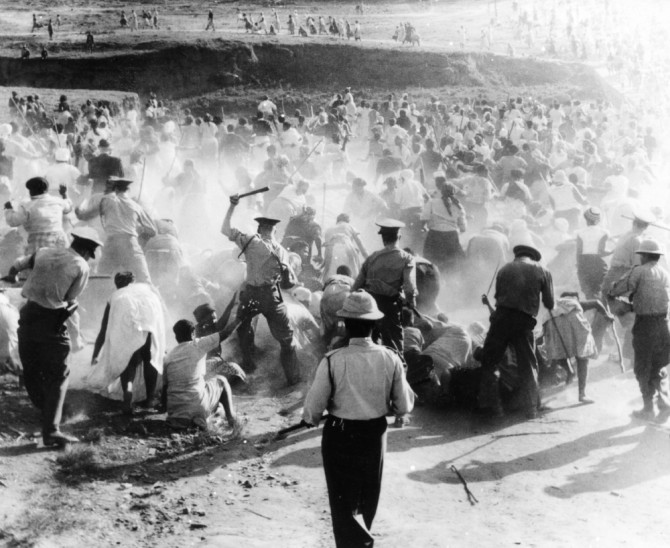The Sharpeville Massacre
The anti-pass campaign, which started as a peaceful non-violent movement led to many controversial effects such as the creation of Poqo and the Umkhonto weSizwe (MK), the armed wing of the PAC and the ANC. Although the Sharpeville massacre led to the imprisonment of many anti-apartheid leaders and the implementation of the Unlawful Organisations Act NO 34, which outlawed the PAC and the ANC. The Sharpeville massacre aroused outrage against the South African government and worldwide support, awareness and sympathy for the anti-apartheid activism in South Africa increased. Dismayed by the actions of the South African government, many countries boycotted the importation of South African goods and labour organisations refused to service South African cargoes. The UN also conducted investigations in to the South African governments legislations and actions in response to the massacre.
"We are grateful that our state department has protected the mass killings of our South African brothers and we are pleased that the UN security council will meet March 29th to consider that outrage."
(letter to Dwight D. Eisenhower, 29 March 1960)
References
"The O’Malley Archives." 1960. N.p., n.d. Web. 27 May 2014. <http://www.nelsonmandela.org/omalley/index.php/site/q/03lv01538/04lv01539/05lv01551/06lv01552.htm>.
"To Dwight D. Eisenhower." To Dwight D. Eisenhower. N.p., n.d. Web. 29 May 2014. <http://mlk-kpp01.stanford.edu/index.php/encyclopedia/documentsentry/to_dwight_d_eisenhower2/>.
"Sharpeville massacre." Wikipedia. Wikimedia Foundation, 26 May 2014. Web. 27 May 2014. <http://en.wikipedia.org/wiki/Sharpeville_massacre>.
"Sharpeville Massacre, 21 March 1960 | South African History Online." Sharpeville Massacre, 21 March 1960 | South African History Online. N.p., n.d. Web. 27 May 2014. <http://www.sahistory.org.za/topic/sharpeville-massacre-21-march-1960>.
"Sharpeville Massacre - 21 March 1960 | The ANC Archives." The ANC Archives. N.p., n.d. Web. 29 May 2014. <http://ancarchives.org.za/sharpeville-protest/>.
Photo taken from http://naturminded.wordpress.com/tag/sharpeville/
Photo taken from http://imguol.com/2012/10/11/conteudo-sobre-o-massacre-ocorrido-em-sharpeville-na-africa-do-sul-1349976512002_956x500.jpg
Photo taken from http://lh5.ggpht.com/Vqe0FaJ-WkrW4T4UfiCquEujHNfywYoR_ZsQuKAk9lF8S-RjJkLTXS0x=s400
Photo taken from http://pbs.twimg.com/media/BjQqcvPCYAE5n8n.jpg:medium
Photo taken from http://www.citylab.com/politics/2013/12/life-apartheid-era-south-africa/7821/
Photo taken from http://imguol.com/2012/10/11/conteudo-sobre-o-massacre-ocorrido-em-sharpeville-na-africa-do-sul-1349976512002_956x500.jpg
Photo taken from http://www.thesouthafrican.com/wp-content/uploads/2014/03/Sharpeville-paper2.jpg
Photo taken from http://globalprep.wikispaces.com/file/view/sharpeville.jpg/204087636/sharpeville.jpg
"The O’Malley Archives." 1960. N.p., n.d. Web. 27 May 2014. <http://www.nelsonmandela.org/omalley/index.php/site/q/03lv01538/04lv01539/05lv01551/06lv01552.htm>.
"To Dwight D. Eisenhower." To Dwight D. Eisenhower. N.p., n.d. Web. 29 May 2014. <http://mlk-kpp01.stanford.edu/index.php/encyclopedia/documentsentry/to_dwight_d_eisenhower2/>.
"Sharpeville massacre." Wikipedia. Wikimedia Foundation, 26 May 2014. Web. 27 May 2014. <http://en.wikipedia.org/wiki/Sharpeville_massacre>.
"Sharpeville Massacre, 21 March 1960 | South African History Online." Sharpeville Massacre, 21 March 1960 | South African History Online. N.p., n.d. Web. 27 May 2014. <http://www.sahistory.org.za/topic/sharpeville-massacre-21-march-1960>.
"Sharpeville Massacre - 21 March 1960 | The ANC Archives." The ANC Archives. N.p., n.d. Web. 29 May 2014. <http://ancarchives.org.za/sharpeville-protest/>.
Photo taken from http://naturminded.wordpress.com/tag/sharpeville/
Photo taken from http://imguol.com/2012/10/11/conteudo-sobre-o-massacre-ocorrido-em-sharpeville-na-africa-do-sul-1349976512002_956x500.jpg
Photo taken from http://lh5.ggpht.com/Vqe0FaJ-WkrW4T4UfiCquEujHNfywYoR_ZsQuKAk9lF8S-RjJkLTXS0x=s400
Photo taken from http://pbs.twimg.com/media/BjQqcvPCYAE5n8n.jpg:medium
Photo taken from http://www.citylab.com/politics/2013/12/life-apartheid-era-south-africa/7821/
Photo taken from http://imguol.com/2012/10/11/conteudo-sobre-o-massacre-ocorrido-em-sharpeville-na-africa-do-sul-1349976512002_956x500.jpg
Photo taken from http://www.thesouthafrican.com/wp-content/uploads/2014/03/Sharpeville-paper2.jpg
Photo taken from http://globalprep.wikispaces.com/file/view/sharpeville.jpg/204087636/sharpeville.jpg

